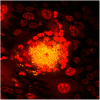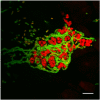Subversion of Host Innate Immunity by Uropathogenic Escherichia coli
- PMID: 26742078
- PMCID: PMC4810123
- DOI: 10.3390/pathogens5010002
Subversion of Host Innate Immunity by Uropathogenic Escherichia coli
Abstract
Uropathogenic Escherichia coli (UPEC) cause the majority of community-onset urinary tract infections (UTI) and represent a major etiologic agent of healthcare-associated UTI. Introduction of UPEC into the mammalian urinary tract evokes a well-described inflammatory response, comprising pro-inflammatory cytokines and chemokines as well as cellular elements (neutrophils and macrophages). In human UTI, this inflammatory response contributes to symptomatology and provides means for diagnosis by standard clinical testing. Early in acute cystitis, as demonstrated in murine models, UPEC gains access to an intracellular niche that protects a population of replicating bacteria from arriving phagocytes. To ensure the establishment of this protected niche, UPEC employ multiple strategies to attenuate and delay the initiation of host inflammatory components, including epithelial secretion of chemoattractants. Recent work has also revealed novel mechanisms by which UPEC blunts neutrophil migration across infected uroepithelium. Taken together, these attributes distinguish UPEC from commensal and nonpathogenic E. coli strains. This review highlights the unique immune evasion and suppression strategies of this bacterial pathogen and offers directions for further study; molecular understanding of these mechanisms will inform the development of adjunctive, anti-virulence therapeutics for UTI.
Keywords: cystitis; effectors; filamentation; immune evasion; intracellular bacterial communities; neutrophils; urinary tract infection.
Figures


References
-
- Schappert S.M., Rechtsteiner E.A. Ambulatory medical care utilization estimates for 2007. Vital Health Stat. Series 13, Data from the National Health Survey. 2011;169:1–38. - PubMed
Publication types
Grants and funding
LinkOut - more resources
Full Text Sources
Other Literature Sources

